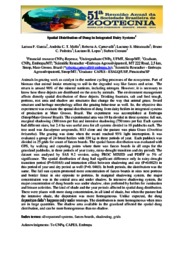Spatial Distribution of Dung in Integrated Dairy Systems.
Spatial Distribution of Dung in Integrated Dairy Systems.
Summary: Animals in grazing work as catalyst in the nutrient cycling processes of the ecosystems. Part of biomass that animal intake returning to soil in the degraded way like faeces and urine. The return is around 90% of the mineral nutrients, including nitrogen. However, it is necessary to know how these dejects are distributed on the area by animals. The environment management affects directly spatial distribution of these dejects. Drinking fountain, salt and feed trough, portress, rest area and shadow are structures that change the way that animal graze. Sward structure and herbage morphology affect the grazing behaviour as well. So, the objective this experiment was evaluate the spatial distribution of dung from dairy heifers in integrated systems of production at Mato Grosso, Brazil. The experiment was accomplished at Embrapa (Sinop/Mato Grosso/ Brazil). The experimental area was 10 ha divided in three systems: full sun, marginal shadowing (300 trees per ha) and intensive shadowing (750 trees per ha). Each system had different sizes, but 2.4 ha was useful area for all systems divided in 10 paddocks each. The tree used was Eucalyptus urograndis, H13 clone and the pasture was piata Grass (Urochloa brizantha). The grazing was done when the sward reached 95% light interception. It was evaluated a group of 24 breed heifers with 350 kg in three periods of year. Each paddock was divided in 25 grids for count of faeces boards. The spatial faeces distribution was evaluated with GPS, by walking and capturing points where there was faeces boards in all steps for the grassland paddocks, in three periods of year (rainy, rainy-drought transition and dry period). The dataset was analysed by SAS 9.2 version, using PROC MIXED and PDIFF to 5% of significance. The spatial distribution of dung had significant difference only in rainy-drought transition period (P=0.0165) and interaction effect between shadowing and site (P=0.0025) in this period of year and dry period as well (P=0. 0465). In both periods, the distribution was the same. The full sun system promoted more concentration of faeces boards in sites next portress and border fence in site opposite to portress. In marginal shadowing system, the major concentration was in the central area and under shadow. In intensive shadowing system, the major concentration of dung boards was under shadow, sites preferred by heifers for rumination and leisure activities. The kind of shade and the year periods affected in spatial dung distribution. There were places with more dung concentration, in all kind of shade, but when the pasture had the intensive shade, the dispersion was more homogeneous. Unlike expected, the dung deposition didn?t happens only under treetops. The distribution is more homogeneous when trees are in large quantities. The shadow area available in the grassland affected the spatial dung distribution, and can be more homogeneous than no shadow.
Publication year: 2014
Types of publication: Abstract in annals or event proceedings
Observation
Some of Embrapa's publications are published as ePub files. To read them, use or download one of the following free software options to your computer or mobile device. Android: Google Play Books; IOS: iBooks; Windows and Linux: Calibre.
Access other publications
Access the Agricultural Research Database (BDPA) to consult Embrapa's full library collection and records.
Visit Embrapa Bookstore to purchase books and other publications sold by Embrapa.

